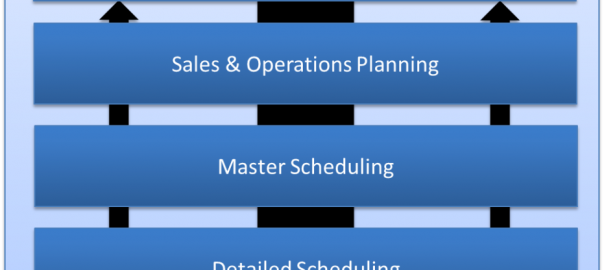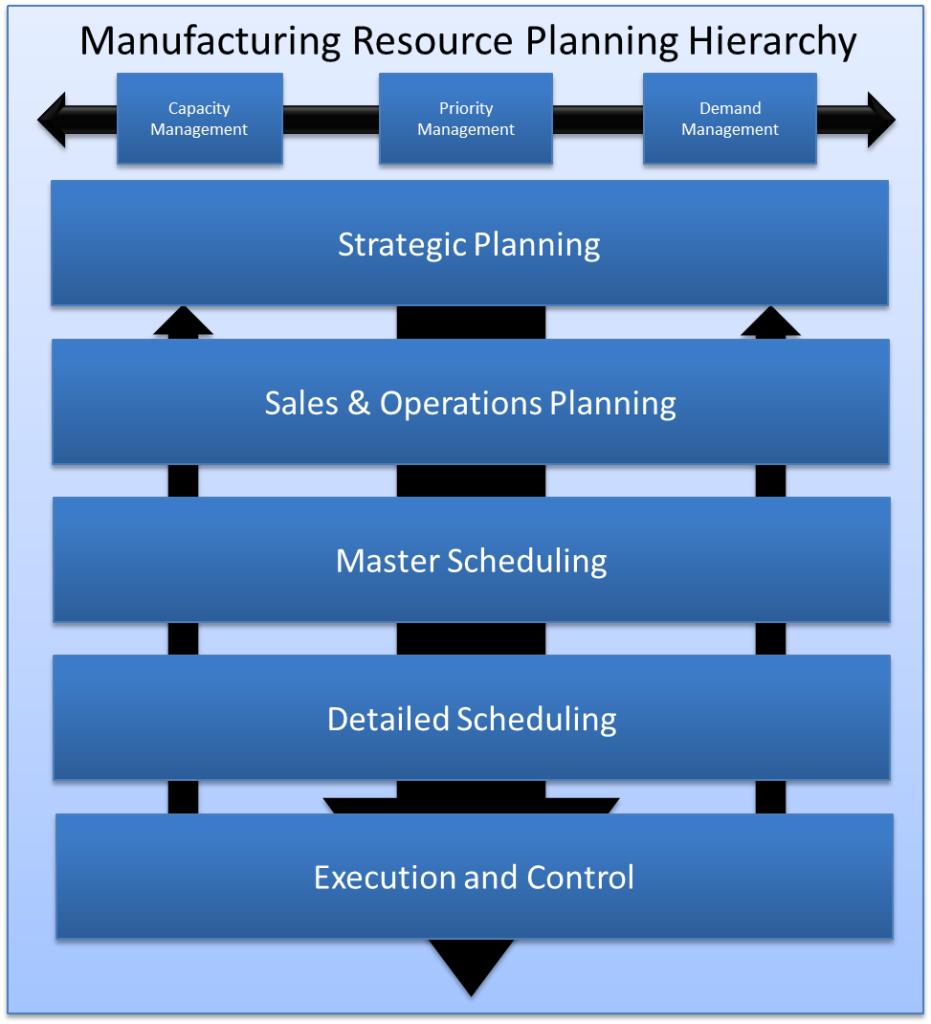Recently I have been thinking about how the Sales & Operations Planning (S&OP) process fits in with the other planning processes within an organisation. A lot is written about the S&OP process and its big brother IBP (Integrated Business Planning) but a lot of it is focused on the S&OP process itself rather than how it fits into the broader planning (and execution!) landscape.
For the S&OP process to be truly successful, it needs to be effectively integrated into the wider planning framework. The S&OP process is only one part of the whole, it is not complete on its own. To explore this further, let’s take a look at the objectives of the S&OP process.
The Objective of the S&OP Process
The overall objective of the S&OP process is to agree on an aligned set of feasible functional plans and targets for the next 18 – 24 periods, consistent with goals and strategy, to be deployed throughout the organisation. As part of the regular cyclical nature of S&OP plans are compared against financial targets, highlighting gaps that need to addressed. Risks and opportunities are formally captured allowing considered responses when guarding against risks and exploiting opportunities.
The S&OP process is generally carried out at an aggregate level, often at product family. This enables the S&OP process to be agile, focusing on enabling aligned decision-making rather than granular precision. The S&OP process should incorporate scenario planning and contingency planning, allowing considered trade-off decisions to be made.
As such, it is clear (hopefully!) that the S&OP process does not meet all of the planning needs within an organisation. For one thing, it’s all well and good that an objective of S&OP is to ensure that plans are consistent with goals and strategy, but where does the strategy come from? And if the S&OP process is focused on aggregate level decision making rather than creating plans with granular precision, how do we ensure there is enough detail to allow execution of the plans when the rubber hits the road? To answer these questions, lets take a look at how the S&OP process is integrated into the broader planning framework.
S&OP Integration: Where does S&OP Process fit in an Overall Planning Framework
On its own, the S&OP process doesn’t offer an end to end solution to planning. It needs to be integrated correctly into the broader planning framework. S&OP is only one piece of the puzzle. A useful model for understanding this is the manufacturing resource planning hierarchy of plans.
As seen above, the S&OP process does not sit in isolation, but rather is only one part of the framework. It is one link in a chain of planning processes that cover the spectrum of strategy to execution, from high level aggregate to granular and precise detail. Lower level processes are more detailed but have shorter time horizons and greater planning frequency. Higher level processes are less granular with longer horizons and lower planning frequency. At each subsequent level the plans are tested for feasibility and the outputs are passed down to the directly sub-ordinate process to act as guide rails. This ensures imbalances in supply and demand are identified in the appropriate time frame where actions are still possible and decisions can still be made to resolve (or at the very least, to prioritise!).
As a side note, it is worth pointing out that the generally accepted hierarchy of plans includes the step of Business Planning between the Strategic Planning process and the S&OP process. I have left this out on purpose. The line between S&OP and Business Planning is progressively blurring as organisations move towards mature S&OP and Integrated Business Planning. It is becoming generally accepted that the financial projections of the Business Planning process should be fully incorporated into the S&OP process.
Lets take a greater look into how the S&OP process specifically is integrated into the broader planning framework. To do this, we will look first at horizontal integration with processes that sit at the same level of detail as the S&OP process.
Horizontal S&OP Integration: Integrating Cross-Functionally
At the top of the diagram of the hierarchy of plans above, you may have noticed a horizontal arrow with three categorised boxes. Lets take a closer look at this.

Functions of the S&OP Process – Capacity, Priority, Demand
Another way of interpreting this is with the concepts of (from left to right) Supply Planning, Supply & Demand Balancing, and Demand Planning. Or in yet another way, as a spectrum from Procurement, Manufacturing & Operations through to Sales & Marketing. It is worth noting that this spectrum is relevent at all levels of the hierarchy of plans, however we are going to focus on how they manifest within S&OP.
One of the components of our earlier definition of the objective of the S&OP process was the agreement of an aligned set of plans. These plans fit within the three categories.
Demand Management: Plans within the Demand Management group focus on providing a forward view of demand and the supporting portfolio.
- The Sales Plan is a time-phased projection of sales based on a supporting set of assumptions. Importantly, the sales plan also includes the ‘how’, with a plan of supporting sales and marketing activities included.
- The Portfolio Plan provides a time-phased view of new products and planned deletions. Also included is a statement of product range for each distribution channel.
Priority Management: Plans within the Priority Management category focus on balancing supply and demand, prioritising resources and buffering for uncertainty.
- The Production Plan (or Supply Plan) is a time-phased projection of production required to meet the demand from the Sales Plan, generally at a product family level. This plan is constrained based on feasibility, with decisions on priority of constrained resources made as part of the S&OP process.
- The Inventory Plan is a time-phased projection of inventory (distribution inventory and raw material inventory) required, generally at product family, based on the Production Plan and the Sales Plan. Inventory plans should also include inventory required to buffer against variability (safety stock).
Capacity Management: This group of plans focus on providing insight into the resources available to support the Production and Supply Plan and subsequntly the Sales Plan.
- The Resource Plan is a statement of any changes in key resources required to meet the Production Plan, Inventory Plan and the Sales Plan. The resource plan should clearly identify the resources required as well as the resources available. The S&OP process allows allow critical resource shortages to be identified in advance so that appropriate action can often be taken to increase resource availability (or if required, to pro-actively dampen demand). Critical resources will vary by industry but typically include skilled labour, key raw material availability and working capital availability.
We can see from this, as part of the S&OP process, plans are integrated horizontally from Sales & Marketing through to Operations and Procurement. Similar (but more detailed) functional integration occurs at each level of the hierarchy of plans. But how is the S&OP process integrated with the processes above and below? Next lets take a look at vertical integration!
Vertical S&OP Integration: Strategy to Execution
Vertical integration (between the different levels of the planning hierarchy) allows a clear connection to be made between high level long-term planning processes and detailed short-term planning processes. In effect, this is connecting the dots between strategy and execution.
You may have noticed on the earlier diagram representing the hierarchy of plans, that the down arrow is more prominent than the upwards arrow. This is because the primary flow of information throughout the planning framework is the downwards flow of plans from each higher level to its sub-ordinate level. The upwards arrows represent feedback loops, which while critically important, should not be interpreted as direct flows of information upwards. Care needs to be taken to use these upwards links appropriately without short circuiting higher level planning process. Lets look at how this works for S&OP:
Primary Flow: Deploying Plans Down.
- The S&OP process operates within the bounds of the goals, targets and strategic imperatives that have been passed down from the strategic planning processes. These goals, targets and strategic imperatives act as guidelines throughout the S&OP process, ensuring that decisions are being made in alignment with the agreed strategic priorities.
- Similarly, the aligned functional plans from S&OP are in turn passed down to the master scheduling processes to become the guide rails for the SKU level plans at this level. In this way, the aligned decisions from S&OP are deployed throughout the organisation. In addition, due to the high level capacity checks that have already been completed as part of S&OP, the plans are already broadly feasible before they are passed down to be planned in further detail. If the detailed demand, priority and capacity planning processes at the master scheduling level are not in alignment (within agreed tolerance) with the higher level plans, this is a trigger to review. If any of the plans require changing for any reason, then this is ok! This is dealt with within the more frequent (often weekly) master scheduling process rather than waiting for the next S&OP cycle.
The Secondary Flow: Integrating Feedback
- Although the S&OP plans do not need to be changed immediately if a variance from the S&OP plan is identified, feedback mechanisms do exist to make sure that changes flow through. This feedback takes two forms. Firstly, in the shorter term horizon (where the S&OP process and the master schedule overlap) the S&OP plans may need to be adjusted in the next cycle (not straight away as this will short-circuit the S&OP process!). The second form of feedback only occurs when a variance is uncovered due to the extra level of detail in the SKU level master scheduling process (and not something actually changing in between S&OP planning cycles). In this case, feedback is provided back into the next S&OP process to allow planners to adjust the mechanisms used to make aggregate assumptions to try and avoid in the future.
As you can see, rather than being a complete planning solution of itself, the S&OP process is simply a single (but important) cog in the larger planning framework. Horizontal cross-functional integration allows alignment between functional areas from Sales and Marketing through to Operations, Manufacturing and Procurement. Vertical integration connects the S&OP process with the business strategy and with the more detailed and frequent planning processes of the master scheduling process. How does your organisation support integration between S&OP and other processes in the business? Have you seen integration handled well? Or have you encountered challenges and obstacles? Please share your experiences in the comments below.
The post ‘Integrating the S&OP Process: Go with the Flow!’ by Mark Pearson appeared first on The Planning Blog.
photo credit: Ben Salter (license)
(396)









